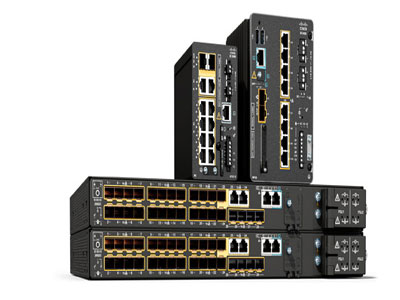Key Takeaway
There are several types of Industrial Ethernet switches, designed to meet specific industrial needs. The main types include unmanaged switches, managed switches, and PoE (Power over Ethernet) switches.
Unmanaged switches are simple and cost-effective, offering basic connectivity without configuration. They are suitable for small, straightforward networks. Managed switches provide advanced features like network monitoring, VLAN support, and redundancy protocols, making them ideal for large, complex industrial setups. PoE switches supply power and data over the same Ethernet cable, simplifying device installations like cameras and sensors. Each type is chosen based on the network’s complexity and operational requirements.
Managed vs. Unmanaged Industrial Ethernet Switches
Industrial Ethernet switches are broadly categorized as managed or unmanaged. The primary difference lies in their functionality and level of control.
Unmanaged switches are simple plug-and-play devices. They require no configuration and automatically route data between connected devices. This simplicity makes them ideal for small networks or applications where advanced features are unnecessary. However, they lack flexibility and monitoring capabilities, which can be a limitation in complex networks.
Managed switches, on the other hand, offer extensive control and monitoring options. Engineers can configure managed switches to prioritize traffic, create VLANs, and implement QoS (Quality of Service). These features are critical for networks that require real-time data handling, enhanced security, or scalability.
For most industrial environments, managed switches are preferred due to their ability to handle complex networks and optimize performance. However, unmanaged switches remain a cost-effective choice for simpler applications.

Layer 2 and Layer 3 Industrial Switches
Industrial Ethernet switches are also categorized based on their functionality within the OSI model, primarily as Layer 2 or Layer 3 switches.
Layer 2 switches operate at the data link layer. Their primary role is to forward data between devices within the same network segment using MAC addresses. These switches are efficient for handling local communication within small to medium-sized industrial networks. They also support VLANs, which help segment traffic for better performance and security.
Layer 3 switches, on the other hand, operate at both the data link and network layers. They perform routing functions using IP addresses, allowing data to travel between different network segments. This capability makes them ideal for larger, more complex networks where devices across multiple subnets need to communicate seamlessly.
One significant advantage of Layer 3 switches is their ability to reduce latency. By combining switching and routing in one device, they streamline communication, which is critical for time-sensitive industrial applications.
For engineers, the choice between Layer 2 and Layer 3 switches depends on the scale and complexity of the network. While Layer 2 switches are sufficient for localized communication, Layer 3 switches are indispensable for large-scale, interconnected systems.
PoE (Power Over Ethernet) Industrial Switches
PoE (Power Over Ethernet) Industrial Switches
Redundant Industrial Ethernet Switches for Critical Networks
Redundancy is a critical requirement in industrial networks where even brief downtime can lead to significant operational losses. Redundant Ethernet switches are designed to ensure network continuity in case of failures, making them indispensable for critical applications.
One of the key features of redundant switches is their ability to support ring topologies. In this setup, switches form a closed loop, allowing data to travel in both directions. If one link fails, data is rerouted through an alternate path, maintaining communication without interruption. Protocols like Rapid Spanning Tree Protocol (RSTP) or Media Redundancy Protocol (MRP) enable fast recovery, often within milliseconds.
Another redundancy feature is dual power inputs, which allow the switch to operate even if one power source fails. This ensures continuous operation in industries like oil and gas, where network stability is crucial.
Some redundant switches also support hot-swappable modules, enabling engineers to replace components without shutting down the network.
For engineers, deploying redundant Ethernet switches is a proactive approach to ensuring network reliability and minimizing the risk of downtime.
Modular vs. Fixed Industrial Ethernet Switches
Industrial Ethernet switches can also be classified as modular or fixed, based on their hardware design and flexibility.
Fixed switches come with a predefined number of ports and features. They are compact, cost-effective, and easy to deploy, making them suitable for networks with stable and predictable requirements. However, their fixed configuration means they lack scalability, which can be a limitation in dynamic industrial environments.
Modular switches, on the other hand, offer unmatched flexibility. Engineers can customize these switches by adding or replacing modules, such as additional ports, PoE capabilities, or fiber optic connections. This adaptability makes modular switches ideal for growing networks or applications with diverse communication needs.
One significant advantage of modular switches is their future-proofing capability. As network demands evolve, engineers can upgrade modular switches without replacing the entire device, saving both time and costs.
While modular switches are more expensive upfront, their scalability and versatility make them a worthwhile investment for large or rapidly changing industrial networks.
For engineers, the choice between modular and fixed switches depends on the network’s current requirements and potential for growth.
Conclusion
The variety of industrial Ethernet switches ensures that there is a suitable option for every application. Whether you need managed switches for control, Layer 3 switches for routing, PoE switches for powering devices, or redundant switches for critical networks, understanding these types is essential for designing robust systems.
For engineers, selecting the right switch involves balancing performance, scalability, and cost. By evaluating the unique requirements of your network, you can choose the ideal switch to ensure efficient and reliable communication in industrial environments.
